1 Invisible Labyrinth
Jeppe Hein, 2005
Hein transformed the empty space of an art gallery into Invisible Labyrinth, using infrared technology in an ingenious fashion. Hein's artwork provides visitors with a pair of digital headphones that vibrate whenever they knock into one of the invisible walls of a maze. While it is deeply engaging to enter one of the work's seven labyrinths, it is also fascinating to observe the uncanny spectacle of gallery-goers navigating indeterminable routes.
2 Proposed Underground Memorial and Tomb for President John F Kennedy
Claes Oldenburg, 1965
Before creating his colossal monuments to things like clothes pegs and matches, Oldenburg proposed various memorials. His Proposed Underground Memorial and Tomb for President John F Kennedy called for a huge, hollow casting, based on a photograph of the assassinated president, to be buried head-down in the ground. The statue's size was identical to that of the Statue of Liberty, as if to suggest that Kennedy's murder had turned the American dream on its head. Two decades after his proposal, the idea of evoking tragedy through absence became a major feature of commemorative projects for the Holocaust and civil violence.
3 Vertical Column of Accelerated Air
Michael Asher, 1966-7
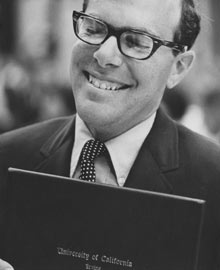 Michael Asher pictured in 1966 at his graduation at University of California, Irvine. Photograph: University of California, Irvine
Michael Asher pictured in 1966 at his graduation at University of California, Irvine. Photograph: University of California, Irvine Yves Klein's Utopian plans for creating an architecture de l'air were cut short by his premature death in 1962. Taking a less grandiose approach to building with air, Asher used industrial blowers to create "walls", "curtains", and "columns" of accelerated air. He would place them in relation to architectural features in a gallery. Visitors would perceive a gentle and unexpected flow of air when walking through the exhibition space which would subtly alter their usual journey.
4 Untitled show
David Hammons, 1995
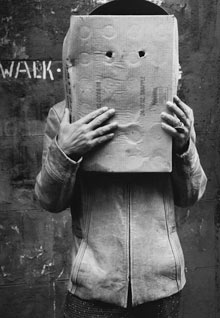 David Hammons hiding behind a box. Photograph: Christopher Felver/Corbis
David Hammons hiding behind a box. Photograph: Christopher Felver/Corbis Over the past 50 years, a number of artists have developed furtive approaches to staging exhibitions. The most brilliant example was by African-American artist David Hammons, who held an untitled and unadvertised show in a New York shop that sold African and Asian artifacts. Not only were Hammons's unlabelled sculptures displayed side by side with the traditional merchandise, but many of his pieces incorporated items from the shop. Playing with boundary issues and cultural camouflage, his artworks achieved their invisibility not by forgoing material form, but by immersing themselves amid the world's cornucopia of things.
5 The Empty Museum
Ilya and Emilia Kabakov, 2004
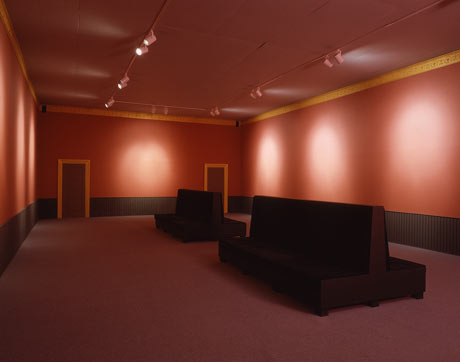 Ilya and Emilia Kabakov's "The Empty Museum,"
2004.
Photograph: Hermann Feldhaus
Ilya and Emilia Kabakov's "The Empty Museum,"
2004.
Photograph: Hermann Feldhaus For the past three decades, Ilya and Emilia Kabakov have specialised in making "total installations", many of which reimagine life in the former Soviet Union with a dark sense of absurdity. Their 2004 installation, The Empty Museum, replicates a room in a classical gallery, featuring a Bach soundtrack and deep red walls that are dramatically spot-lit. But where we might expect to find paintings on the walls, there are only pools of light. What has happened to the art? Haunted by absence, the Kabakovs' eerily theatrical installation invites us to write our own script.
6 Double Torso
Andy Warhol, 1966
Warhol produced a few "pornographic" paintings in the mid-1960s using fluorescent inks that were only visible under ultraviolet light. Along with his film Blow Job (which shows only the face of a man on the receiving end of the eponymous sex act), his invisible canvases were provocations aimed at the harsh anti-pornography laws of the time, which tightly controlled what could or could not be seen. His interest in invisible media would pop up at several times in his career as if he were seeking an antidote to his own overexposure as a celebrity.
7 Untitled (A Curse)
Tom Friedman, 1992
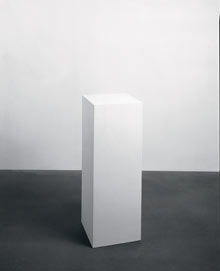 Untitled (A Curse) by Tom Friedman, 1992
Photograph: Image courtesy the artist and Harry Handelsman
Untitled (A Curse) by Tom Friedman, 1992
Photograph: Image courtesy the artist and Harry Handelsman In 1992, Friedman created Untitled (A Curse), which appears to be nothing more than a pedestal. But he had employed a professional witch to cast a curse on an 11-inch sphere, resting 11 inches over the pedestal. At the time he said he was thinking about "how one's knowledge of the history behind something affects one's thinking about that thing". And once you read how it was made, Friedman's pedestal becomes a loaded object that tests the roles that belief and imagination play in our encounters with art.
8 Radiation Piece
Robert Barry, 1969
In the late 1960s, Barry began producing artworks using a range of immaterial media, including electromagnetism, radio waves and ultrasonic sound – forms of energy that, as he noted, "exist outside the narrow arbitrary limits of our own senses". His Radiation Piece has a tiny amount of caesium-137, a radioactive isotope released into the atmosphere during nuclear tests and accidents. It has a "half life" of 30 years, but continues emitting energy forever (although in ever-decreasing quantities). For Barry, who found ideas of nothingness and the void to be extremely potent, radiation was a means of evoking something immeasurable and without limit – the sublime realm of the unseen.
9 The Specialization of Sensibility in the Raw Material State into Stabilized Pictorial Sensibility
Yves Klein, 1958
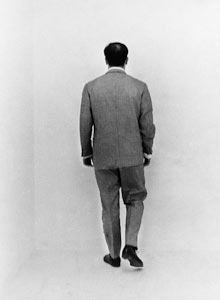 In the Void Room (Raum der Leere) by Yves Klein,
Museum Haus Lange, Museum Haus Lange, Krefeld, January 1961.
Photograph: bpk/Charles Wilp, DACS London, 2012
In the Void Room (Raum der Leere) by Yves Klein,
Museum Haus Lange, Museum Haus Lange, Krefeld, January 1961.
Photograph: bpk/Charles Wilp, DACS London, 2012 In the history of invisible art, perhaps the most visible landmark remains Yves Klein's 1958 exhibition at Galerie Iris Clert in Paris, The Specialization of Sensibility in the Raw Material State into Stabilized Pictorial Sensibility – an empty gallery, apart from a single cabinet, in which every surface had been painted white. Klein maintained that the space was saturated with a force field so tangible that some people were unable to enter the exhibition "as if an invisible wall prevented them". Others may have been unable to enter because spectacular press coverage ensured huge queues of spectators searching for something to look at.
10 Untitled (Horse)
Bruno Jakob, 2003
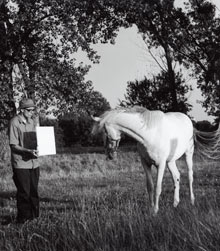 Untitled (Horse) by Bruno Jacob, 2003
Photograph: Courtesy the artist & Galerie Peter Kilchmann, Zurich. Photo: collaboration with Peter Püntener
Untitled (Horse) by Bruno Jacob, 2003
Photograph: Courtesy the artist & Galerie Peter Kilchmann, Zurich. Photo: collaboration with Peter Püntener Swiss artist Jakob has devised several different means of making "invisible paintings": painting on paper or canvas using water rather than pigment or exposing a lightly primed canvas – as if it were a psychically sensitive type of photographic paper – to the presence of a person or animal in order to capture some ethereal aspect of their existence. This photograph of the artist holding up a blank canvas towards a horse might seem like an absurd gag, yet at the same time it earnestly conjures an unseen connection between man and animal that no straightforward portrait could convey.
Invisible: Art About the Unseen, 1957-2012 is at the Hayward Gallery, London, from 12 June until 5 August.
Source: www.guardian.co.uk
No comments:
Post a Comment